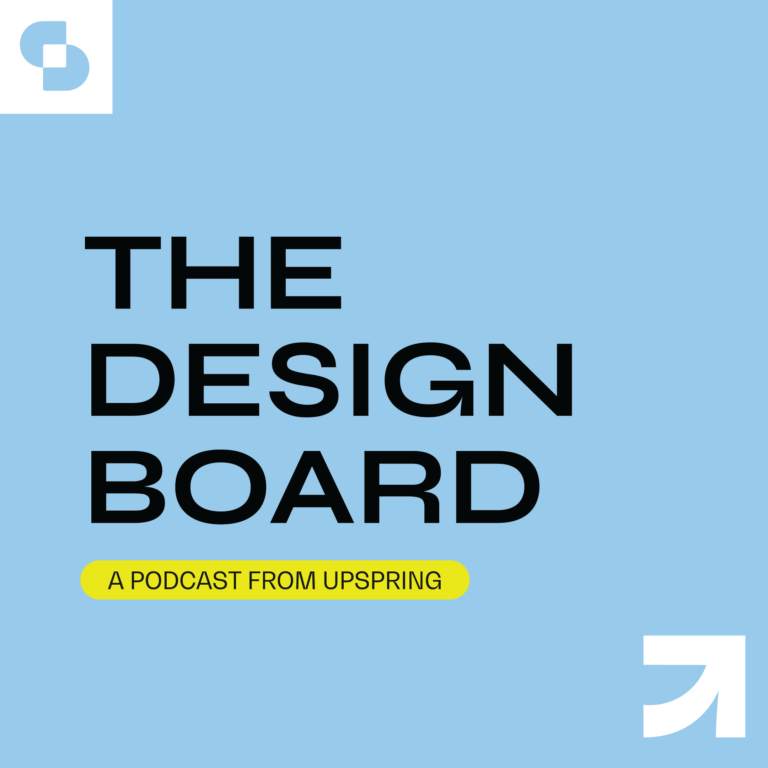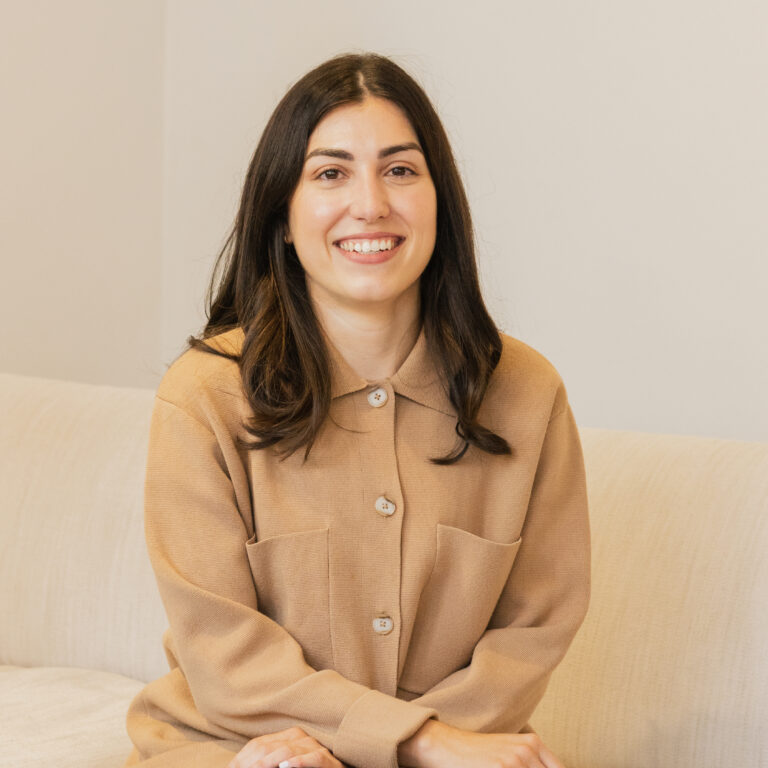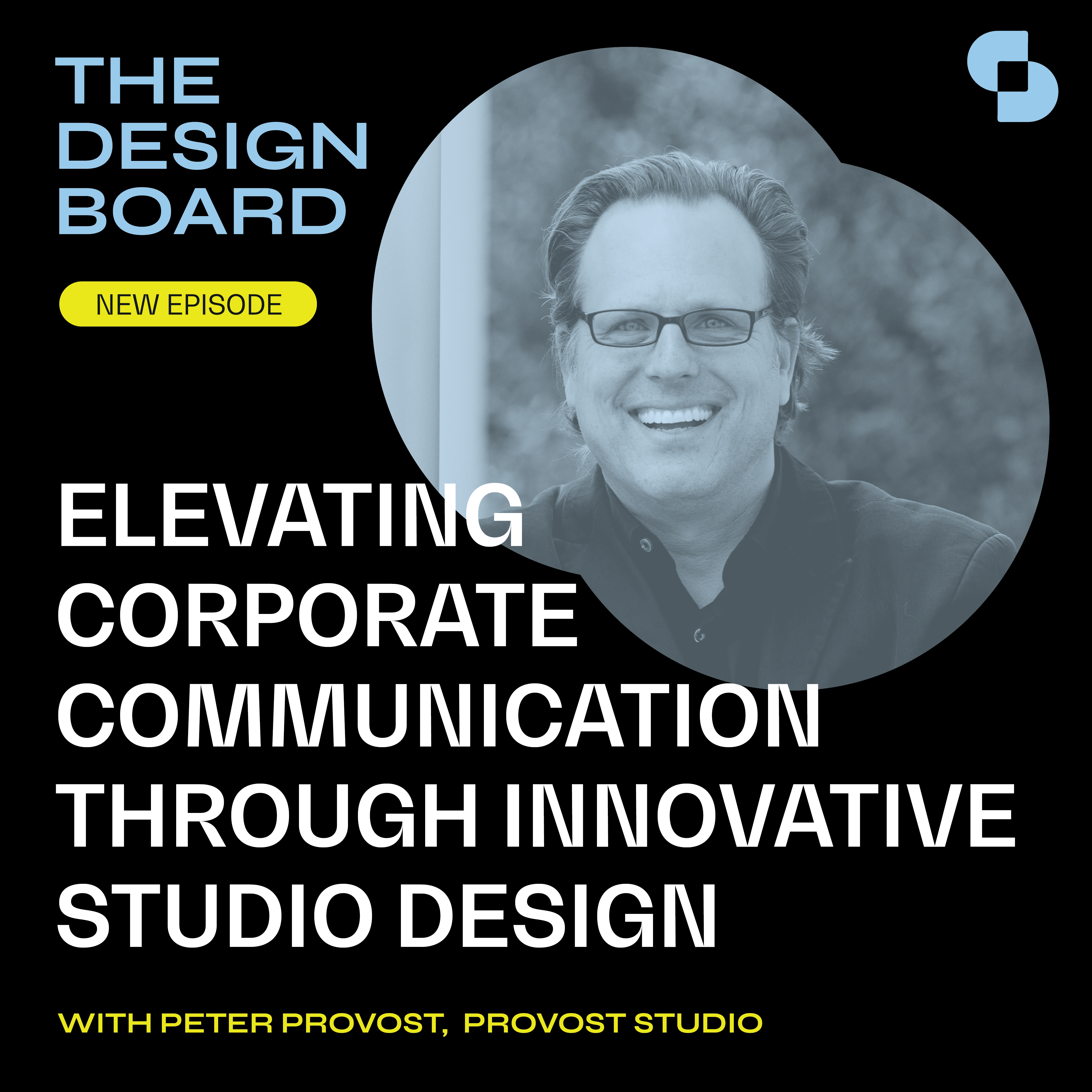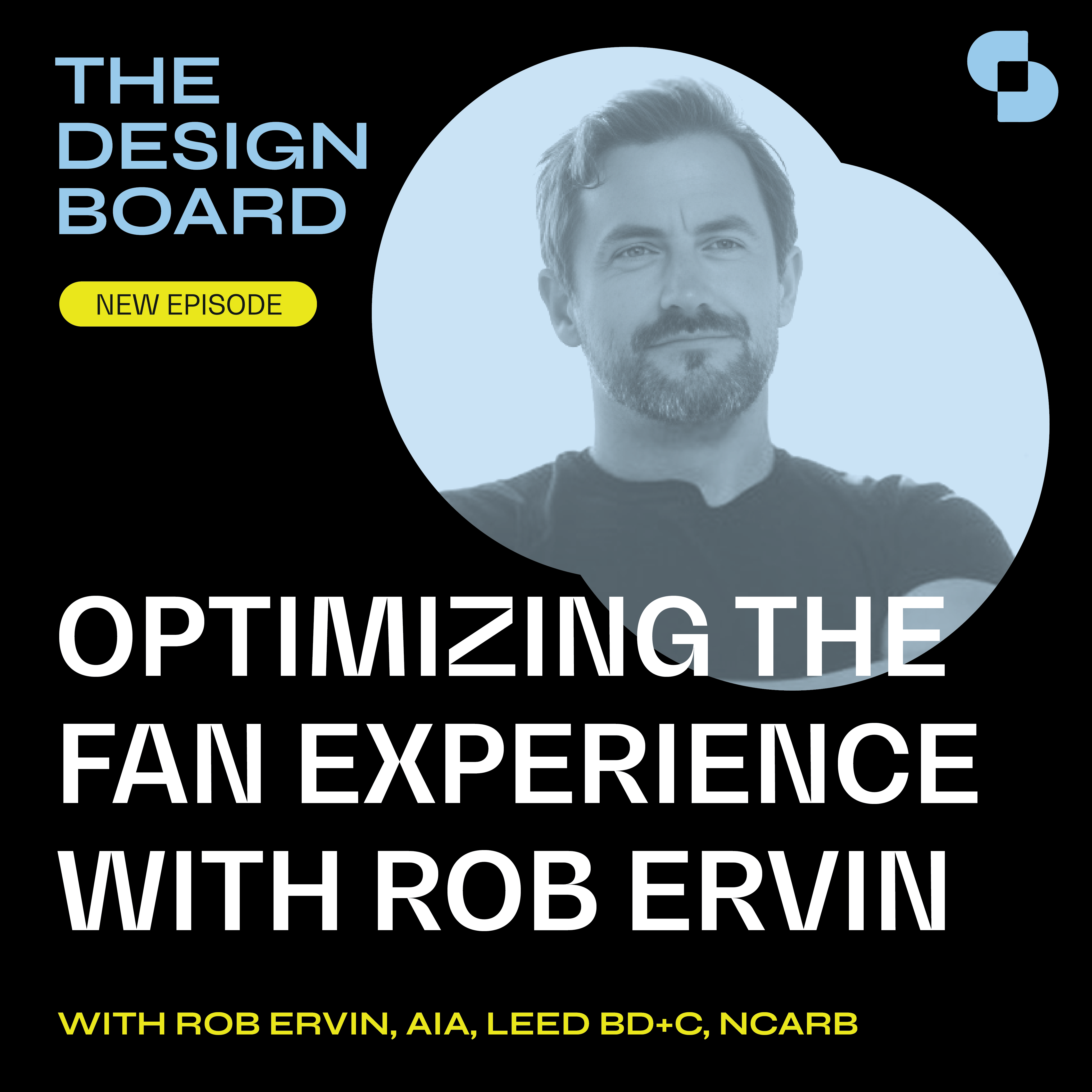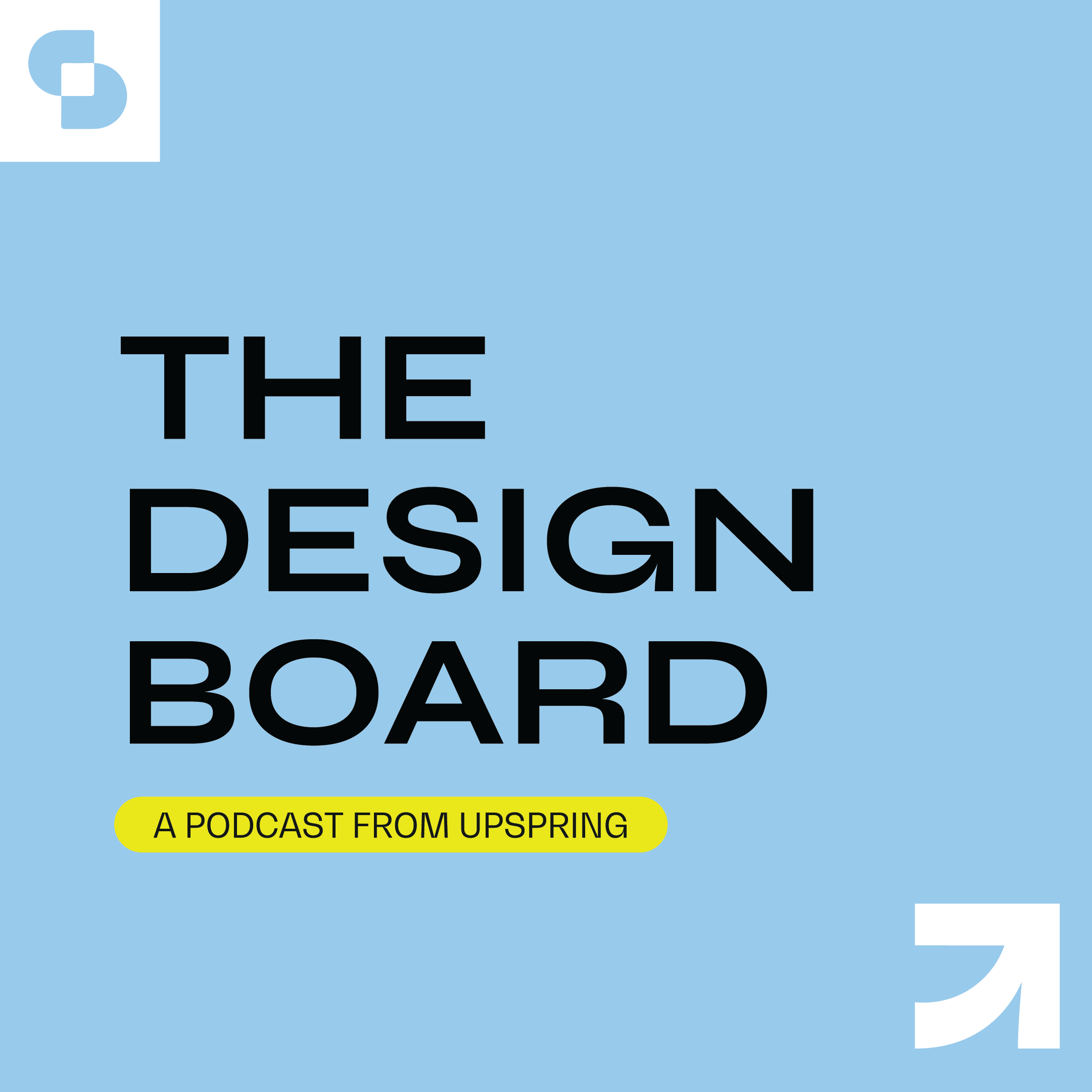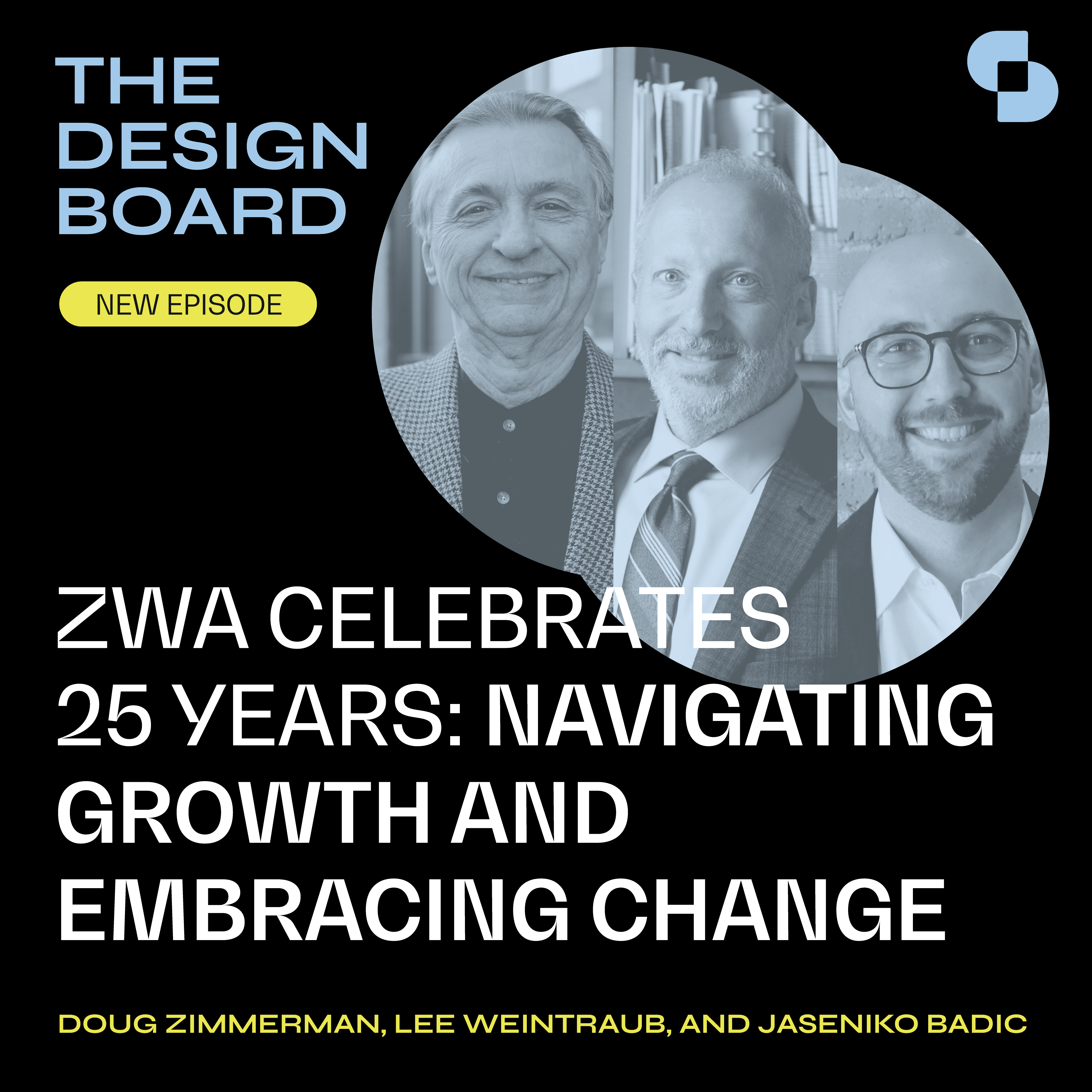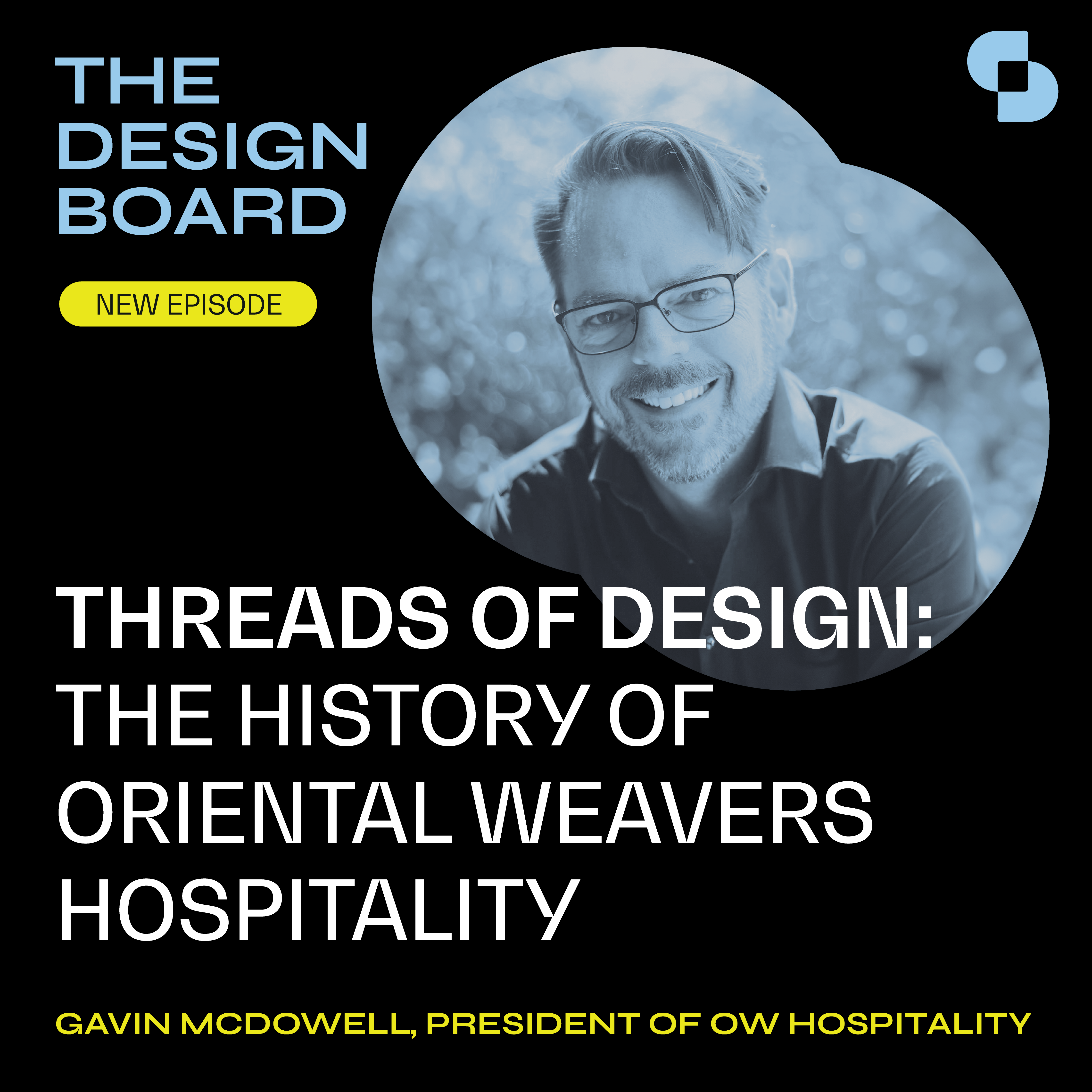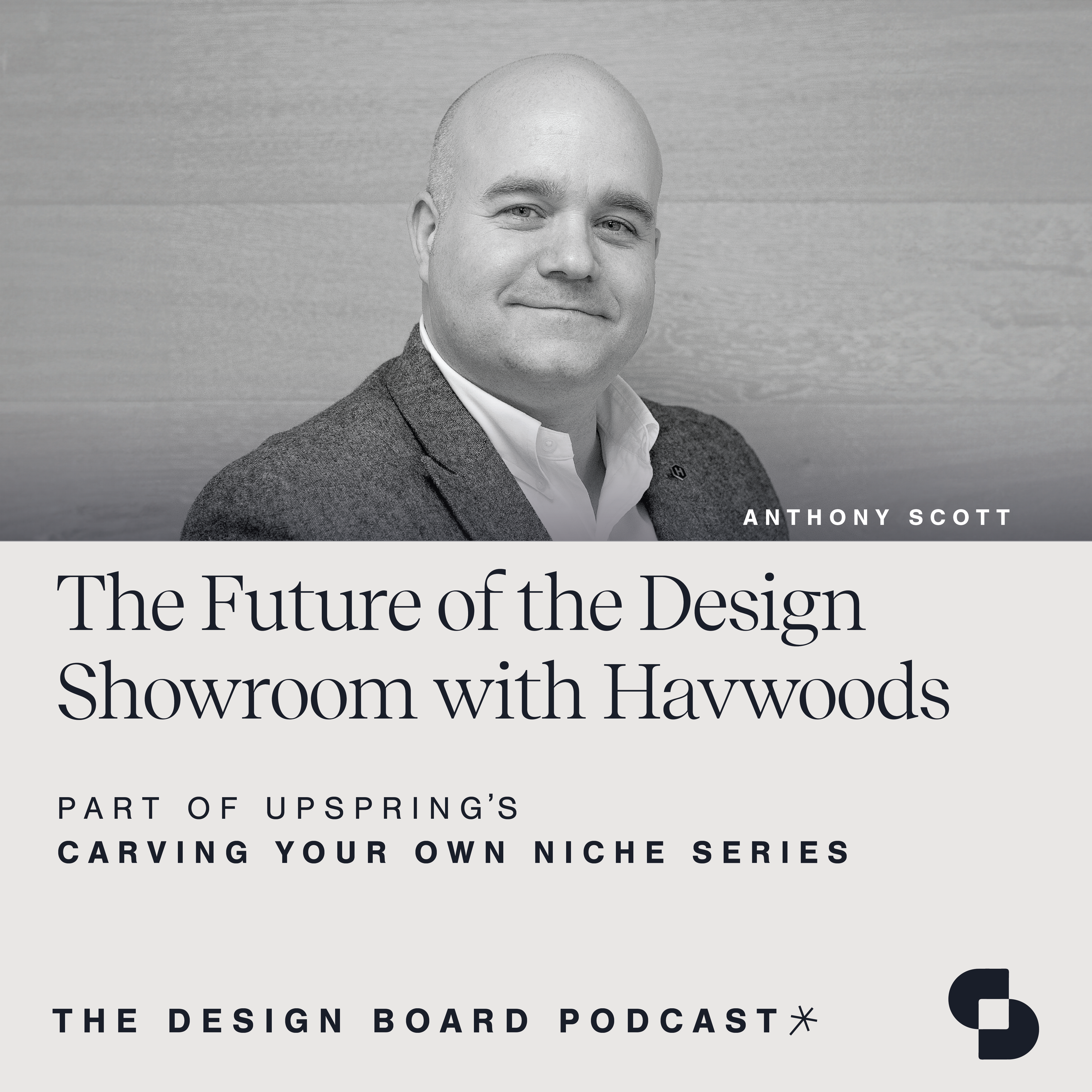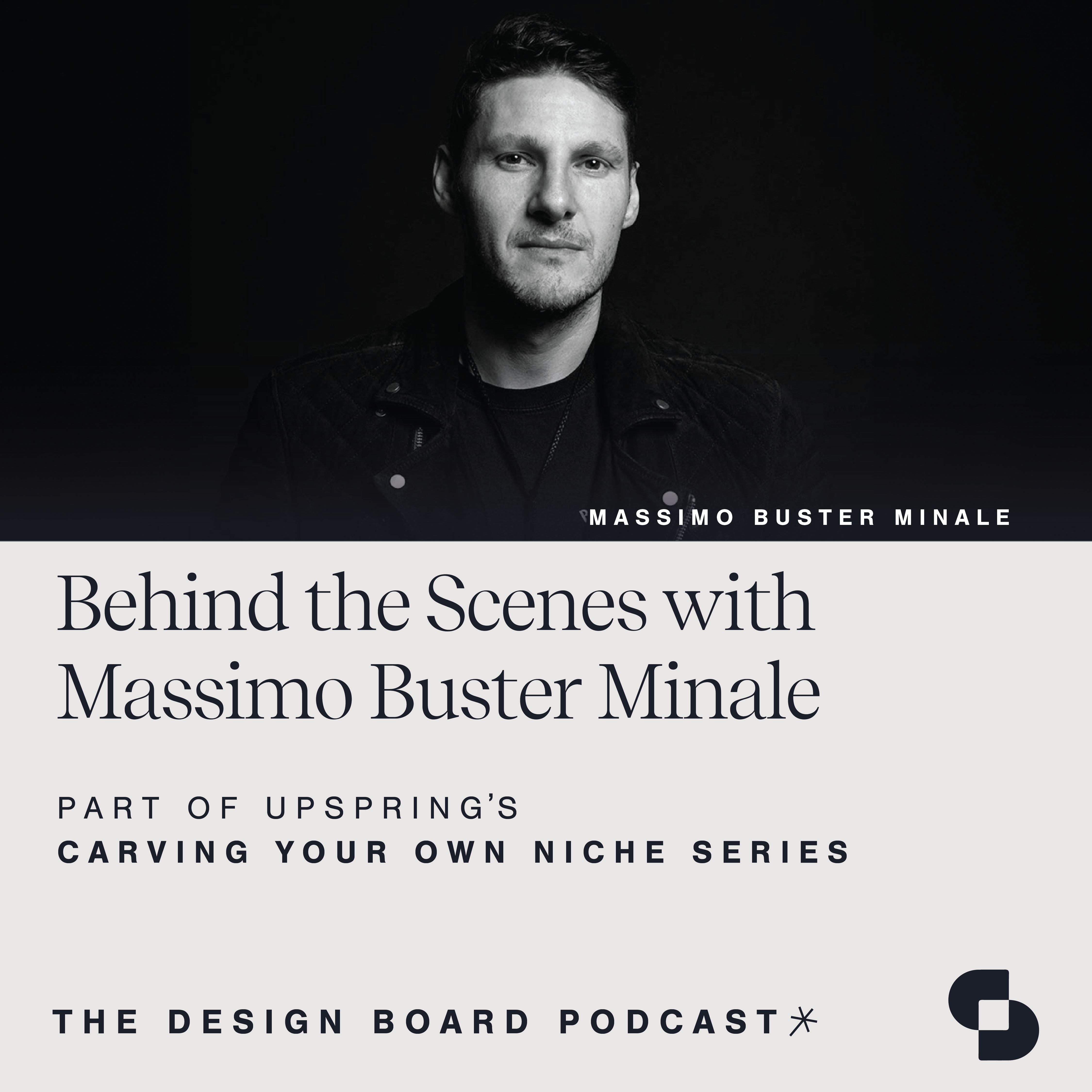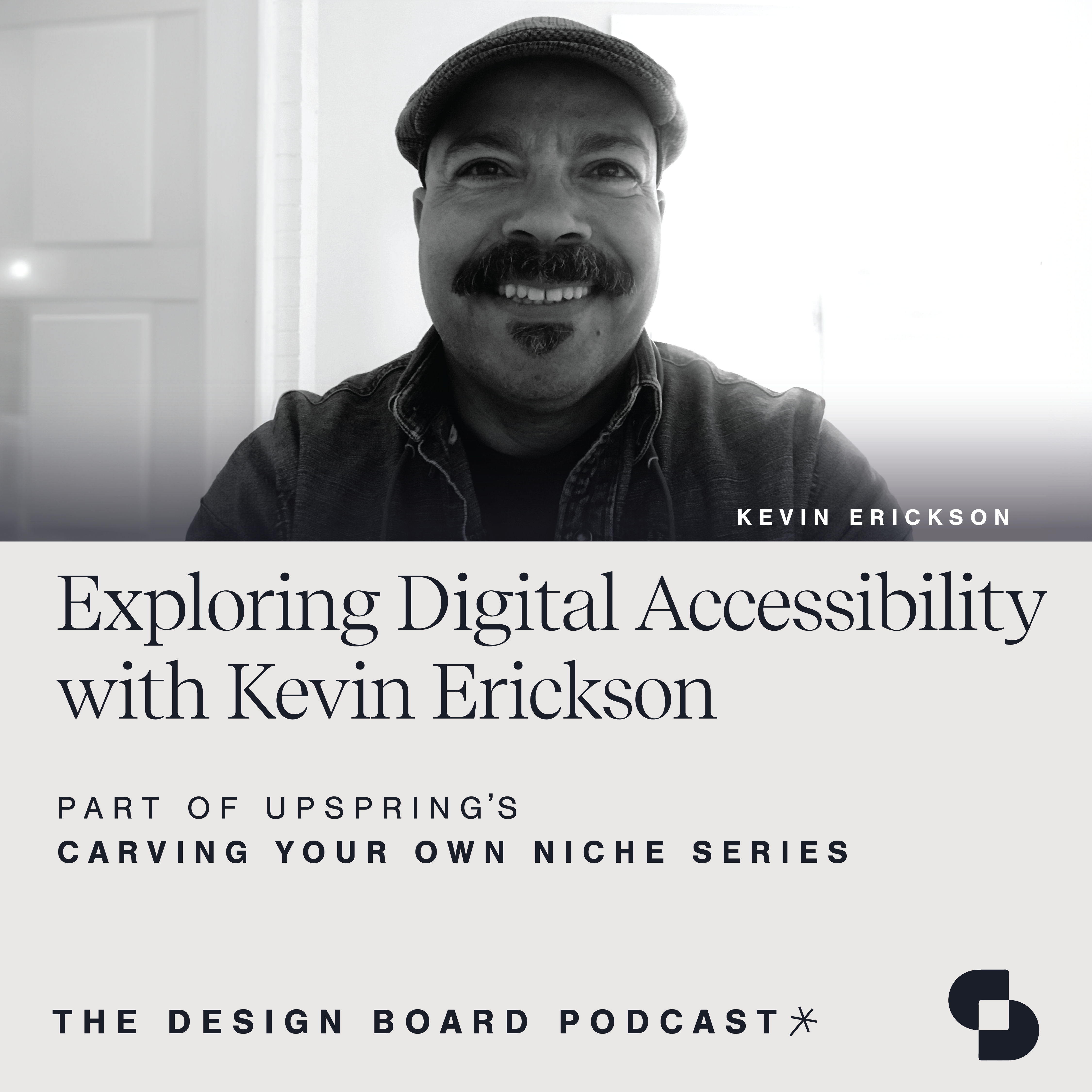Host Caroline Saba welcomes two distinguished leaders from the International Interior Design Association’s New York Chapter (IIDA NY): Robin Reigi and Elisabeth Mejia, Co-Vice Presidents of the Chapter’s Student Development. They will explore the different facets of mentorship, career development, and networking strategies for emerging design professionals. Learn how to best support the next generation of designers and architects and play a pivotal role in their career development.
The Design Board, by UpSpring, is a proud member of SANDOW Design Group’s SURROUND Podcast Network, home to the architecture and design industry’s premier shows.
Speaker 1: Welcome to the Design Board, a podcast created by the team at Upspring that focuses on design, development and everything in between. We invite innovators in our industry and explore topics that support your growth in every way. The Design Board is a proud member of Surround, a podcast network from Sandow Design Group, featuring the architecture and design industry’s premier shows. Check it out at SurroundPodcast.com.
Caroline Saba: Welcome, everyone, to another episode of the Design Board. I’m your host, Caroline Saba, Vice President at Upspring. Today, I’m joined by two distinguished leaders from the International Interior Design, Association’s New York chapter, also known as IIDA New York. I’m joined by Robin Reigi and Elisabeth Mejia. Together, they serve as co-vice presidents of the Chapter of Student Development Initiatives, which offer events and partnerships that strive to educate and inspire students of all ages and backgrounds.
Over the past year, IIDA New York has provided invaluable resources to help guide students on their professional journeys. A great example is the chapter’s Hazel Siegel Scholarship, in which three students were awarded an all-expense paid three-day trip to the IIDA Texas-Oklahoma Chapter SHIFT Student Conference in Dallas. Acknowledging this crowning achievement, IIDA awarded IIDA New York the Changemaker Award for the Hazel Siegel Scholarship in 2023.
Today, we’ll discuss how industry professionals can effectively contribute to the growth and success of the emerging generation of designers and architects, playing a key role in shaping their career paths. It’s an honor to have you both with us, and I’m so excited to chat more with you about the importance of Student Development. Before we dive in, I’d love to give our listeners some context into your roles at IIDA.
Can you both tell us a little bit more about what this looks like in IIDA’s New York Student Development, and the different committees dedicated to supporting design students?
Robin Reigi: I’ll go ahead and start. One of the things that we loved most about joining Student Development is that it’s a relatively new group in IIDA New York. I believe that Elisabeth and I were actually only the second full team to be in charge of students, Student Development.
We worked together previously as co-chairs at Design Camp, and then I took my predecessor, Dan Villella’s place, and Elisabeth eventually came over and took her predecessor, Katie Battaglia’s place. I think we’ve been working together for about what, five years, right, Elisabeth?
Elisabeth Mejia: Yeah. We have about five teams under this umbrella, and we encompass everything from K through 12, as well as graduate and undergraduate student.
Robin Reigi: We always like to start with Design Camp. It’s a really fun and dynamic group. It’s led by Rachel Robinson of Ted Moudis and Elizabeth Jimenez of MKDA. This committee is a lot of fun because it serves students under college age, and while most of our initiatives have been with high school kids, we’ve even held events and initiatives that include elementary and middle schoolers, like our partners with ACE, and also with our own internal community.
Elisabeth Mejia: With Design Camp, we’ve had a really successful tour with FIT for Pre-College. It’s really starting to foster that connection of what it means to be in the design community, what it means to get started in this career, and being able to see what that looks like at a college level, and then how that kind of carries through into their respective careers and paths for school.
Robin Reigi: Of course, we always like to make sure that we acknowledge our wonderful college ambassadors. I always like to say if we were a rock band, the college ambassadors would be the bass player. They’re really always just sort of there, maybe not front and center, but this kind of grounding force that holds the whole operation together, quite honestly.
Elisabeth Mejia: Our team is led by Ethan Lu, who’s an assistant professor at FIT and Julia Glazer of Kimball. It’s really such a joy working with them and this team, because they have so much experience there in working with schools and outreach with the students and the faculty. That’s really an important connection to have when we’re trying to grow Student Development and get these students involved. Ethan’s kind of like our Oracle, in a way.
Robin Reigi: We run everything past him first before we make a major decision, right?
Elisabeth Mejia: We really do.
Robin Reigi: Just want to reach out to all of our college ambassadors. I think we have what, Elisabeth, about six or eight of them?
Elisabeth Mejia: Yeah, something like that.
Robin Reigi: They do all of our recruiting for our initiative, so they’re up close and personal with the schools, the chairs of all of the departments, and they’re just absolutely critical to our whole operation. They also work with other committees, like for instance, the Catalyst committee led by Jennifer Graham and Sherry Simcoe, who give laptops away annually. I think they’re up to what, their third now. These are just wonderful initiatives, I think, that we always want to make sure that we recognize because they’re just so important and critical to our cause.
Caroline Saba: That’s incredible. That background’s so helpful. The whole idea of the Student Development and mentorship I think is just crucial for the AEC industry. I’d love to hear too some recent examples that the team has put together that you felt have really had a positive impact on design students over the past year.
Robin Reigi: Well, I’ll have to start with our Hazel Siegel scholarship, which is now in its third consecutive year. This was really our very first big initiative that Elisabeth and I did together. It came about quite organically. Hazel was a beloved and dedicated member of our community and chapter, and she passed away in 2020, and that’s when I first came aboard. I had never met Hazel, but the chapter really wanted to do something to commemorate her in the form of maybe a contest, some type of competition.
It took us quite a while to know where we wanted to go with it, especially during the COVID era. Ultimately, our president at the time, Elsie St. Léger, approached us and said, “There’s this SHIFT conference in Dallas where students get together, and they have all this amazing three days worth of mock interviews, and speakers, and all this wonderful stuff, and wouldn’t this be a great thing to maybe send our students to?”
It was really not a connection at that time to have anything to do with Hazel, but we were sort of dying to come up with something at that point, feeling the pressure, like, “What are we going to do here for Hazel as time’s going by?” Elisabeth, I think you remember.
Elisabeth Mejia: Yeah. Really, from that, Hazel was such a prominent figure in students, and teaching, and really fostering the next generation. It really flowed into being able to have that direct impact on what our students can experience. We’ve been able now to send nine students. They always come back, and the energy, talking about mentorship there, it kind of starts that connection. They have been active participants in our chapter now since then.
Robin Reigi: It was just so funny the way it all came together, because here we were, looking for this way to honor Hazel, and then this SHIFT opportunity came up and we were like, “Gee, how can we get the students there? Where are we going to get the budget?” We were like, “Oh, wait a minute. We have this money that we set aside for this Hazel competition, and we haven’t figured out what to do with yet. Why don’t we put it all together?”
Then it was like this Oprah sort of aha moment, and before you knew it, we were kind running with it. Now it’s in its third year. We created a committee, which of course, is now led by Michelle Schutt of CertainTeed, and Jillian Allerton of Gensler, and they’ve just kind of run with it and made it so much more professional and advanced. I think we’re up to about 40 applicants-
Caroline Saba: Amazing.
Robin Reigi: … This past year, and it’s a springboard for all of our other initiatives, which hopefully we’ll have an opportunity to talk about next. With that, everything just sort of grew from there. Our students, just to talk about how successful they’ve been, have gotten internships at Corgan, NYU, Gensler, hopefully we’ll have a chance to even talk about that more, but there’s just been a whole myriad of opportunities that have sprung forth from that.
Caroline Saba: Yeah, I love that. It’s so cool to see too, that initial idea, and how that’s transpired to really impact a variety of different students. That’s great. A little bit on the same lines, what about mentorships between design professionals and students? Can you walk through some examples of that, and how the team has helped to foster some of those connections?
Elisabeth Mejia: Yeah, I think one of our biggest ones was this new initiative that we started this past year that really fosters to connect and engage students with our sponsors as well as design professionals. Robin came up with this term, trying to think about how we could relate and everything, so we called it SUP, which stands for Student Uplift Program. It really is that way of talking to the students.
They wanted something to create a connection, not just with their fellow classmates, but other schools, but then how can it be a segue into the design industries to be able to start those professional connections? We always want to sit there and explore how we can bridge everyone together. We had a really successful event this past fall at Perkins & Will, and it was so well attended, and equal from all around, from all three sides. It was just amazing to see those connections start to foster.
Robin Reigi: I would agree. I think one of the things that we really kind of found our voice through this particular initiative is, as Elisabeth had said, always looking for ways to make connections between all of the players in our industry. In mentorship, I think it’s easy for a young designer to say, “I find a more established designer, and they’ll mentor me, and help me with my portfolio, and make connections with firms.” We wanted to go a little bit deeper, not only to engage our students more with the chapter, but also to get all the various members of our chapter and our community at large to our students.
From my perspective as an industry person, that also meant sponsors. Through SUP and allowing our top tier sponsors to each sponsor one student membership, and building that into the sponsorship package, so there was no additional cost, there wasn’t a lot to have to think about, it gave a sponsors of ownership to come in and really be part of mentoring in a way that I haven’t really seen other people engage sponsors before.
In doing so, of course, as Elisabeth said, it was very successful, but it kind of lit a spark in us and said, “This is a way that we can define Student Development and build our own brand,” if you will, and our impact in the industry by bringing people together in a way, and engaging them in a way, that we haven’t really seen others do, and breaking them out of those kind of individual silos that we see so often, the event silo, and the student silo, and so on. This has kind of really been helpful in that process.
Elisabeth Mejia: I think with that too, it really started to break down barriers in a sense with students, because we’re always looking at how can we engage more students, and what is going to make them be involved in the chapter? A lot of times, a student membership is what that blocking point is for them. Involving the sponsors to say, “Hey, look, let’s get students involved. Let’s get them involved in the chapter, make connections with you. They are up and coming designers, the next generation.”
Getting them to see the value and the connections to be made from that, starting those points for the mentorship, or even just exposure, there’s some things in school that you just don’t have experience to, and being able to get in the industry and see the various perspectives.
Caroline Saba: Yeah, I love that. That’s so great. I’d love to break it down a little bit more too because there’s so much that IIDA New York offers, but even just for listeners who are looking for a mentor, what are some steps that you would suggest someone to take? Once you find that mentor, what does it look like from there? What do those conversations look like in order to continue their professional development and growth?
Elisabeth Mejia: I think mentorship, it’s always that it can’t be forced, but it can be asked for. It might not be something that you’re automatically paired with someone and you’re a mentor, because there are programs out there like that. I know IIDA New York has done once in the past where we had like speed mentorship, and you get paired with a professional.
Sometimes those pairings are very successful, and sometimes they’re not, but it has to almost happen, finding what, I think for me, when looking for a mentor, it’s finding on what you’re seeking to gain, and kind of being honest with yourself on that, of what part of the industry, what part of your career, where are you looking to grow, and what is the value in that mentorship, and the opinions that you’re looking for in the professional?
I think expanding your search on that is really important, of not getting stuck of, “I love hospitality design, so I’m only going to look for mentors in hospitality design.” I think that really kind of is short-sighted in the sense of there’s so much more aspects to get a diverse perspective and a more well-rounded perspective. Broadening your network when looking for mentors, and whether that be business, we’re all business in some sort of this industry here, and business design, different aspects, vendors, all of that, that offer these varying perspectives.
Robin Reigi: I agree. Certainly from the vendor perspective, I always advocate for young designers to think from the industry side in terms of seeking mentorships. I personally have mentored quite a few young designers who are now pretty established in their careers, but were students at one time or another. Sometimes, to echo, Elisabeth, what you were just saying, sometimes it’s really about needing help with a portfolio, or perhaps negotiating a salary, but other times, really just having that influence, working with somebody that’s been in the industry for many years that can basically help you with courage, and advocating for yourself, and knowing the questions to ask.
Those tend to come out organically, those relationships. If they don’t work, you should probably just politely move away and maybe look for new relationships, but when they do work, they can be really lifelong. I certainly have some folks that I’ve worked with, primarily females, but also some young men as well, who to this day, we still keep in touch. I learned from them as much as they learned from me. It’s such a valuable relationship if you’re fortunate enough to have one.
Caroline Saba: Yeah, I think that’s such great advice. It’s kind of sensible when you say it out loud, but setting goals before entering a conversation or a relationship with that mentor, what do you actually want to achieve? Like you’re saying, whether that’s something specific on negotiating salary, or maybe it’s gaining more confidence in presentations, but I think going into it with something that you want to get out of it helps to really figure out what that conversation looks like with that person. That’s great advice.
Robin Reigi: If I might add, just being open to a happy surprise. I’ve had a couple of interns over the years who thought they were going to intern at a design firm in the summer, and things didn’t work out, and they knew they had to get something. They said, “Hey, can I intern for you, Robin?” We’d say, “Sure.” Turns out that we were able to give them something that they never really even thought that they would be able to get, just by kind of falling into something and being open to it.
Yes, you should definitely have goals. We’re great believers in goals, but sometimes just kind of accepting what comes into play, and happy accidents can be the most rewarding experiences of all, so that’s okay too.
Caroline Saba: Yeah, I totally agree. I think that one of the best pieces of advice I got seven years or so ago is mentorship is everywhere. It could be anything in any conversation, a book that you pick up and read, a TV show that you’re watching. That’s great advice too. On the flip side, so what about professionals at firms, or product manufacturers that are interested in being a mentor, just becoming more involved with student designers? Do you have any tips on how to navigate that, and how for them to get involved with mentoring the next generation?
Elisabeth Mejia: Yeah, I think too, kind of the same advice that it was for students, for mentees, you have to be honest with yourself how much you can commit. I think that’s the biggest step. You don’t want to over commit to something, because mentors see that value. Being able to be there, and provide value, and that true mentorship is what’s important and truly impactful.
If it’s just one person, having that impact on one person makes a huge difference. There’s students that I’ve mentored that I was early in my career, and I still stay in touch with them now too, and they send me life updates. It’s great. It’s because I had that time and I committed to that time. That’s the biggest thing is committing to it, I feel. You have to be willing to do that and honest with yourself.
Robin Reigi: If I could just get on my personal soapbox about this from the industry side, I challenge manufacturers and industry people to be open and seeing the value of mentoring designers. I think that all too often nowadays, and especially post-COVID, a lot of people from my generation, which is Generation X, sort of feel like this, “Gen Z, and what are they? They’re so elusive. They’re this sort of enigma generation. They don’t value human interaction and relationships. We can’t get to them.”
It’s really not true. If you do take the time to get to know young people of any generation, and mentoring is quite certainly just a wonderful way to do that, you’ll notice that that assumption is actually not true. The students and young designers of this generation, post-COVID generation in particular, just value very rich and very meaningful and authentic interaction. If you can do something digitally, and it can be accomplished remotely, they’re probably going to do it, because they don’t see much point in doing it the old way, the hard way.
If you give them rich experiences and true value in those interactions, they’re all about it and they come back for more. We see that again and again in our student work. The students are the first ones to sign up for our events, and participate in things, and engage. For industry people that are looking to connect and want to stay relevant, this is the way to do it and have it be in a way that’s truly meaningful: building trust, building relationships, and of course, building brands, but more importantly, building that relationship that feels like a personal connection as opposed to a connection with a product or brand.
Elisabeth Mejia: Yeah, I think some of the designers too, getting involved, you want to mentor the next generation, but it’s also a two-way street. I find such value myself as a designer in learning from the students, learning from the next generation. I have the experience and the expertise, any professional that’s been in the industry does, but there’s also value in listening to the ideas, the creativity. There’s untethered, way out there ideas that we’ve kind of been so ingrained in the industry to stay focused in one way of what’s tangible.
This out of the box thinking and different ways of looking at things is just as much valuable and insight to bring in that partnership.
Speaker 1: I love that. I love that you’re both saying too, how important that personal connection is too, going beyond the firm, beyond the brand as well. What about specific platforms or programs that help to facilitate mentorship between design professionals and students? Is there anything that you would recommend?
Elisabeth Mejia: Not as a platform for IIDA, but I think it’s really important and really vital to be involved in the industry. That’s really the jumping board for anything else that you’re going to do to find those connections and mentorship. There are so many programs offered through professional memberships that gear towards students. Our Student Development committees alone, kind of the ones that we’ve listed already, but beyond that, there’s the events, the networking, just being involved in the know.
Robin Reigi: Yeah, we have some great partners. I think we might’ve alluded to ACE mentorship that we work with through Design Camp that we absolutely love. We have some folks actually within our team that do consulting. I’ve done some Google searches out there just for mentorship, and there’s quite a bit of them out there, but there’s so much within our own little community here at IIDA that we can do for students.
Even at their own schools, we’re consistently very impressed with a lot of the schools and what they’re doing for their own students, and helping them engage, whether it be NYSAT is doing some amazing stuff, our upstate schools, RIT, Syracuse. There’s just so much going on within our own community, and we just continue to encourage everybody to kind of come together as much as possible.
Also, if we could, I don’t know if this is off-topic, but I just want to really make sure that we have the opportunity to shout out to our students. I think it’s easy to kind of lose sight of the actual people that all of this is for. We have such an incredible network of students, and it’s a growing network. When we first came onto this, Elisabeth and I, we were losing students, because it had been COVID and we didn’t have that many student members. We came in and said, “We have to double our student membership, and we have to get them more engaged.”
Now, we have this very, very present cream of the crop, really. Students that sign up for stuff and show up for things are already going to be the best of the best. Through all of our programs, Hazel Siegel being probably at the top of the list, Knowledge Forum, which is an all student-led committee, Ashley Abaunza and Giuliana Grosso do a wonderful job leading that team, we are really able to see everything come together and feed one another.
I think that’s the most important thing. If we could just give a shout out to what our students are doing, it’s so incredible and so impressive.
Caroline Saba: Yeah, that’s so nice to hear too. I love that. I’m sure they’re creating communities within their groups as well.
Robin Reigi: Oh, sure. Well, remember, and I know that we mentioned this, but many of the schools, most of them have their own what we call campus centers, which are clubs that the schools have for IIDA, and of course, other great organizations, like NOMA and others, ISID. There’s lots of really great organizations out there.
These students have their own campus centers, and that’s what we call them for IIDA, where they have their own little networks, and then they kind of do outreach and stuff. It’s just this sort of exponential growth that starts to happen, and we just love that we’re just a really good part of that.
Caroline Saba: Amazing, I love that. We started hinting about this in a few earlier questions, but about the synergy between mentor and mentee, and the relationship that gets created. Can you offer some guidance on how to establish those long-term relationships? Then any advice on steps to take when you’re starting to feel like the relationship is maybe mismatched?
Elisabeth Mejia: I think Robin said this a little bit before. I think it’s okay to acknowledge that maybe this isn’t the right fit, and kind of gracefully excuse and say, “Thank you.” You’ve gained value out of it. That’s one thing, personal experience for me, really starting in the industry in my job, there’s always value to something, and whether that’s learning what you don’t want, I think, has just as much value in learning what you do want.
When you’re paired with those mentorships that you’re seeing, it’s not quite going well, it’s not quite going both ways, kind of admitting it and being like, “Okay, I learned something from this, and it was very valuable in this moment. Now I know what I want to seek in elsewhere, or seek from someone else, or a different expertise or part of the industry.”
Robin Reigi: I would agree. These relationships are organic, and sometimes somebody that you might not have as much to mesh with today could possibly come back next year, and that relationship could gel in a very different way as people change and needs change. The important thing is just to remember that like every relationship, there’s chemistry, there’s synergy, and there’s a life to it to a certain extent, so kind of relax with it.
Again, getting back to what you were saying earlier, Caroline, we always advocate for goals and setting expectations, but then just being open about where that all goes and how it develops. I certainly know that within our groups and our organization here at IIDA, we do everything that we can do to help foster and move those relationships along, whether it be a long-term mentorship that we set up with SUP, or even within our events, our kind of mantra is that everything that we do should be educational, inspirational, and fun.
When you come to one of our events, we literally have people that are walking around, introducing, we really take the name tag thing seriously. We take a lot of pictures together, we have a lot of hugs. We keep it really fun and informal, and remember that this is students, and there’s a lot of young people. You could be a student at any age, but primarily these are young adults, and this is our opportunity to enjoy our time together, and have some fun, and kind of not take it all so seriously.
I think when you keep that stuff in mind, and you realize that these relationships are just, at the end of the day, human relationships, it takes a lot of that pressure off. We try to do that, but we always encourage others to do it independently as well.
Caroline Saba: I love that. I love what you were saying too about the relationship might not be right now, but it could be right a year or two years later. Always keeping that in mind, even if it feels mismatched in the moment. Then I love what you were just saying too about creating fun environments, because that hits on my next question. We were starting to talk a little bit about Gen Z, and especially too, in the hybrid area, they’ve been through the pandemic.
They probably had classes remote as well, and I was actually having a conversation the other day with a younger employee and they were saying, “How do you make small talk?” I think you hit on that, right? The name tag, someone going around introducing, to help them feel safe and comfortable, but any other suggestions to really help foster that community?
Robin Reigi: This is kind of my area of expertise. I’m the queen of small talk.
Elisabeth Mejia: That’s what I was about to say. Robin is like the person at these event. Yes.
Caroline Saba: I love it.
Robin Reigi: I’m a salesperson. I come from a family of salespeople. Hopefully I have a little bit more to offer than just that aspect of it, but you never want to be kind of stale about things and say somebody’s name over and over again, and over touch, and all those weird corny things that we kind of hear about how to network and stuff.
It’s really, to me, I think, creating first of all, an environment where people are comfortable. We always really go out of our way to have a lot of opportunities for people to feel good about the space. There’s a sort of a win-win-win element to our events. There’s always a dedication where we’re kind of talking about somebody that’s done something really well, and we have things to talk about.
Then when people are in that environment together and you’re introducing someone, you kind of bring them together and say, “Hey, I’d like you to meet Elisabeth. Elisabeth just got a fantastic promotion at HKS, and she’s a senior designer now, and I think, Caroline, you’d really appreciate knowing a little bit more about that. Caroline does these wonderful podcasts, and talks to designers every day.”
Before you know it, Elisabeth and Caroline are just having this really meaningful conversation. That can be done with a third party, and it’s always really nice when there’s a host that’s doing that for you, but once you understand that conversational ease and also asking more questions than talking about yourself is such a really, really important social tool that I use. People think they’re having this great conversation, and they are, but a great conversationalist is really asking more questions than they’re talking about themselves.
Those are kind of things that I use in these environments to keep people kind of lubricated. Our events are dry events, by the way, so there’s no alcohol at these events, so people are getting warmed up and cozy with each other just because the conversation is easy, and the environment is very low-key, and very friendly, and non-intimidating.
Caroline Saba: I love that.
Elisabeth Mejia: Adding to that too, I have met some incredible people through Robin just at these events, doing exactly what she said, knowing that we have this connection together, and having that instinct of, “Oh, Elisabeth, there’s someone you’re working on this project, or this or that, you would really click well with this other person. Here, let me introduce you.”
Kind of experiencing that and having kind of that experience, in a sense, it makes me more aware when we have these student events of, as a professional, how can I do that for others, and not even just students, just like other colleagues? It really is such a great connection. A great point. It is hard to network. For me too, I don’t care how many years you have, networking is awkward.
From that, it’s just kind of making those connections when you have someone that you have clicked with that you get along well with recommend someone, or even make that connection for you, it kind of eases that tension. It brings your anxiety down a little bit, makes you more able to chat and have a more personal conversation.
Robin Reigi: I would also just add, if I might, there’s a lot of differences in how various cultures interact with one another. In the US here, we’re a smiling culture. The handshake kind of comes and goes. We’re kind of huggers when people are feeling safe in terms of pandemics and stuff. This may date me, I’ll say that, but I’m pretty big on eye contact. I’m pretty warm physically, personally, and I try to remember names. I’m not always the very best at it, but these kind of just very basic social skills, I think, sometimes get lost.
I always remind students, you remember the person’s name, do that little LinkedIn follow up. Hopefully we’ll have a chance to talk about digital media platforms in a moment, but have a good firm handshake, especially for women. If you do have the chance to shake somebody’s hand, that’s a wonderful opportunity to show them how powerful and how courageous you are. Make that eye contact, make a good handshake, put your shoulders back, put your head up high.
Those kind of body language things are so important, and it really is the thing that gives you that edge, which, let’s face it, this is New York, this is a competitive place. I always say if you’re one in a million, there’s eight of you in New York City. You have to have that competitive chutzpah at you. Those kind of little techniques really go a very, very long way. I always encourage students to remember to put them in place.
Caroline Saba: I love that.
Elisabeth Mejia: I think with that too, there’s an aspect of when you talk about networking, you think of really industry networking, going to these events and everything. Really, one thing for younger professionals entering the workforce is you kind of forget that that networking happens in the workplace too. You have to network within your company, especially if you’re working for a large firm. Making those connections with higher-ups, with your other colleagues, is the same thing.
Exactly what Robin was saying, that eye contact, shoulders back, being able to shake someone’s hand, being able to go seek someone when you need information, and kind of knowing how to do that. It’s not just like when you speak of networking, networking isn’t just an outward action. It’s not just an outward thing within the industry. It’s within your career.
Caroline Saba: This is so great. I could talk about this all day. I love these practical tips.
Robin Reigi: This is my favorite part.
Caroline Saba: Me too, because there’s so much about it. I think going back to what you were saying, Robin too, at the end of the day, we’re all humans, and we’re all craving connection. I think that much is true. We’ve learned that since the pandemic. What does that really look like when you are in the room with different individuals, whether you’re at a networking event, or Elisabeth, like you’re saying, when you’re in the office? I think this is great advice.
Robin Reigi: If I could just touch on that again, I think it always reminds me of one little note about just being in the world is that, and sometimes people laugh when I say this, but I’ve said it before and I’m going to say it again, if you’re an introverted person, I think especially probably have to remind yourself of this a little bit, but remember that every person you come in contact with when you’re out in the world is meaningful and important.
I can’t even tell you how many times I’ve been out in the world, and again, as a salesperson, an industry person out there, you go into these buildings, and you see the same guys at the front desk, checking you in, receptionists. There are women in our industry, or men too, but a lot of women receptionists that we all know go back for 20 years. It’s very easy to be dismissive of people that you view as not being important enough for you, and get that right out of your head.
Every person you come into contact with anywhere in the world, whether it’s the person that you walk by on the street, whether it be that needy person, you might not be able to give a dollar today, but that doesn’t mean that that person doesn’t have value. That superintendent, that janitor that’s walking by, these people, every interaction that you have has meaning, and it comes back tenfold. I can’t stress that enough. Don’t choose just the important people when you’re out there, networking in the world.
Choose all people, and realize that the more you give to society, the more you get from society, but you’re not doing it just to get. You’re giving because giving is good, and you will actually get back. I know I sound like a real hippie saying that, but it is the truth, and it is the way to go through life, whether it be professionally or personally. I just have to make sure that I have the opportunity to say that anytime I can, because it’s what I live by in life. I see it proven so many times.
Caroline Saba: Yeah, it’s so true. I wholeheartedly agree. I think in sum, be kind, be nice, no matter who you’re interacting with. Then I always like to go back to the saying, interested people are interesting. I think that hits on what you both were saying as well. Ask questions, be engaged, and show that engagement too through your body language. Robin, you brought this up as well, social media, I think the big picture in the room, LinkedIn.
Can we talk a little bit about what does networking look like online? How do you make those interactions? Do you connect with someone? Do you message someone? Do you have any practical tips and tricks for people?
Elisabeth Mejia: I’ll talk from the designer aspect of it. I think it’s fantastic to connect with other designers, but also other industry professional, including reps. You see stuff coming out, you see things from manufacturers. I think there’s a little bit of an intimidating with connecting with someone. What we were saying before, when you connect with someone in person, you want to make that personal connection. Same thing goes with LinkedIn.
I know someone has said before, and it really resonated with me, of, if you’re going to connect with me on LinkedIn, send me that personal message: where we met, something that we talked about that I’m going to remember and respond. Then I know I’m going to look up for you in the future, or continue to interact with your post, or whatever you might be doing. Sending a blind connection doesn’t really give you much to go on, and I don’t know how much people accept and don’t accept. I think for me, it just depends on how many people I’m connected to that’s related to that person, but it’s really that personal touch.
If I met you at a networking event and you didn’t get my email address, and you just wanted to say, “Hey, let’s connect, I found you interesting. I would love some insight on something,” send that message, “Hey, I met you at the SUP event. It was really great chatting with you about X, Y and Z. Next time you happen to be here, let’s get together,” or, “I have a project coming up, would you mind giving me feedback on?” That is just so much more impactful to me, because it tells me that you took the time to make that connection yourself, and I’m going to reciprocate that time that you took.
Robin Reigi: I agree. I love LinkedIn. It’s actually the platform that I use more than anything else. It’s where I have the most connection, so it’s probably also a kind of a self-fulfilling prophecy. I love some of the new things that they’ve done with the platform. For instance, you can use creator mode now, which gives you more freedom to follow people and also have people follow you, which is really nice, but you still maintain the privacy of your connections.
I use it quite a bit when I go out, and let’s say, I do a presentation at an architecture firm, and I see 20 or 30 people at one time. I’ll go to LinkedIn afterwards, and I’ll go to the page of that firm and go to the people section, New York. Then I’ll just go right through it and make sure that I’m linked in with everybody there that I met that day, or refresh or whatever. I do use it for follow-ups, because I find that it’s a nice way to kind of check in with somebody that I just saw that day and be like, “Hey, it was really great to see you today.”
It kind of sticks out for them sometimes. I don’t know that every designer necessarily does messaging on LinkedIn, but I find more often than not, when designers are getting so many emails in their regular inbox, this almost stands out a little bit. I find that I actually have more successful response that way. I just love, also, just my last thing about LinkedIn, I love that you have the opportunity to put more content. I can be a little verbose, and that is a content, a place where we can put more narrative.
Whereas Instagram, if you put more than three words, then you look kind of like old, fuddy duddy, but with LinkedIn, you have the opportunity to really put a lot of stuff and tag. We always tag our sponsors, and we tag everybody involved, and try to get that kind of viral thing going. It’s just great. Now, Instagram is great too. We do a lot of stories and things, but I just feel like there’s a little cut above with LinkedIn that, for me, just feels more professional and has more depth.
Elisabeth Mejia: Yeah, I think that’s a great networking tool too, not only just to make those connections, but especially when you’re starting your job searches. Actually, several students that I’ve connected with in the past, or younger designers, or even just peers that have reached out and said, “Hey, I see that you work at HKS. Can you tell me a little bit about it? I’m looking to interview with them,” or seeing that you have a second or third connection to someone, and you’re really close to that connection.
It’s a way to expand and utilize your network, not just for updates, and who’s doing what, and all that social interaction, but to really utilize it to grow your career.
Caroline Saba: Yeah, I think you both offered great tips and suggestions. I love LinkedIn too. I feel like I learn something new every time I’m scrolling through, whether someone’s posting content, or walking through a how-to, or even seeing people connecting or interacting. It’s such a helpful tool.
Robin Reigi: It kept us busy during COVID. My partner and I turned our showroom into a video making studio, and basically just did videos all the time.
Caroline Saba: That’s amazing.
Robin Reigi: As soon as COVID ended, we stop making videos. It really kept us busy. It was a lot of fun to use that as a platform for how-tos and things, for materials.
Caroline Saba: Yeah, that’s great. Well, this has been such a helpful and inspiring conversation. I really appreciate you both offering your insight and ideas, and really showing us some real world examples too. Thank you both so much for being here today.
Robin Reigi: Thank you. Can we just do a quick shout out for our upcoming career night, Caroline, if you don’t mind?
Caroline Saba: Yeah, please.
Robin Reigi: Okay. On February 29th, which is coming up now in less than a month on leap year, we’re going to be having our very first career night. What that is going to be, many ways, like an old-fashioned career fair. We’re going to have portfolio reviews, which are going to be held by Knowledge Forum, our wonderful student-led committee, which we’re very excited about.
We’re going to have mock interviews, which is going to be led by Design Camp. We’re going to have our sponsors engaged in mock interviews. Elisabeth, I’m sure you’re going to talk about your segment.
Elisabeth Mejia: Yeah, and then we’re also going to have a fireside chat, ask, open forum discussion. One of them focused on exactly what we’re talking about here, students and professionals entering the workforce, but then also looking at those professionals that are emerging professionals, and how to jump and move into the next level. That would be with myself and some other professionals in the industry too.
Robin Reigi: We’re going to have guests from almost all of our allied firms up to about 25 design professionals from Gensler, HLW, HKS, of course. It’s going to be a bit of a star-studded event. I would just be very neglectful if we didn’t thank our president, Alex Davis, Alexandria Davis, who really encouraged us to do this big event in the winter, and really wanted us to engage with the chapter and create something that would be very impactful.
We took Alex’s direction and kind of ran with it. We’re just really thrilled to bring everybody together for this. We’re also going to invite our friends at Upspring and hope that you can make it as well, Caroline.
Caroline Saba: Yeah, of course. I have to after this conversation.
Robin Reigi: We’re going to have a headshot studio as well, so you can come in and get your picture taken-
Caroline Saba: Oh, awesome. I need one.
Robin Reigi: … [inaudible 00:41:44] too. You can come and get the headshot refreshed.
Caroline Saba: I’ve aged since my last headshot.
Robin Reigi: Oh, [inaudible 00:41:49].
Caroline Saba: It’s time.
Robin Reigi: Yeah. You can come, have a mocktail, and then you’ll come in and get your headshot taken.
Caroline Saba: I love it.
Robin Reigi: Take in a forum.
Caroline Saba: Amazing. This is great. Thank you both for sharing that. Thank you again for being here with us today.
Robin Reigi: Thank you.
Elisabeth Mejia: Thank you.
Speaker 1: Thank you so much for listening in with us today. We hope you leave inspired by the ideas in today’s episode. For more, follow Upspring on LinkedIn and Instagram. Don’t forget to check out the amazing lineup of shows brought to you by the Surround Podcast Network, at SurroundPodcast.com.

